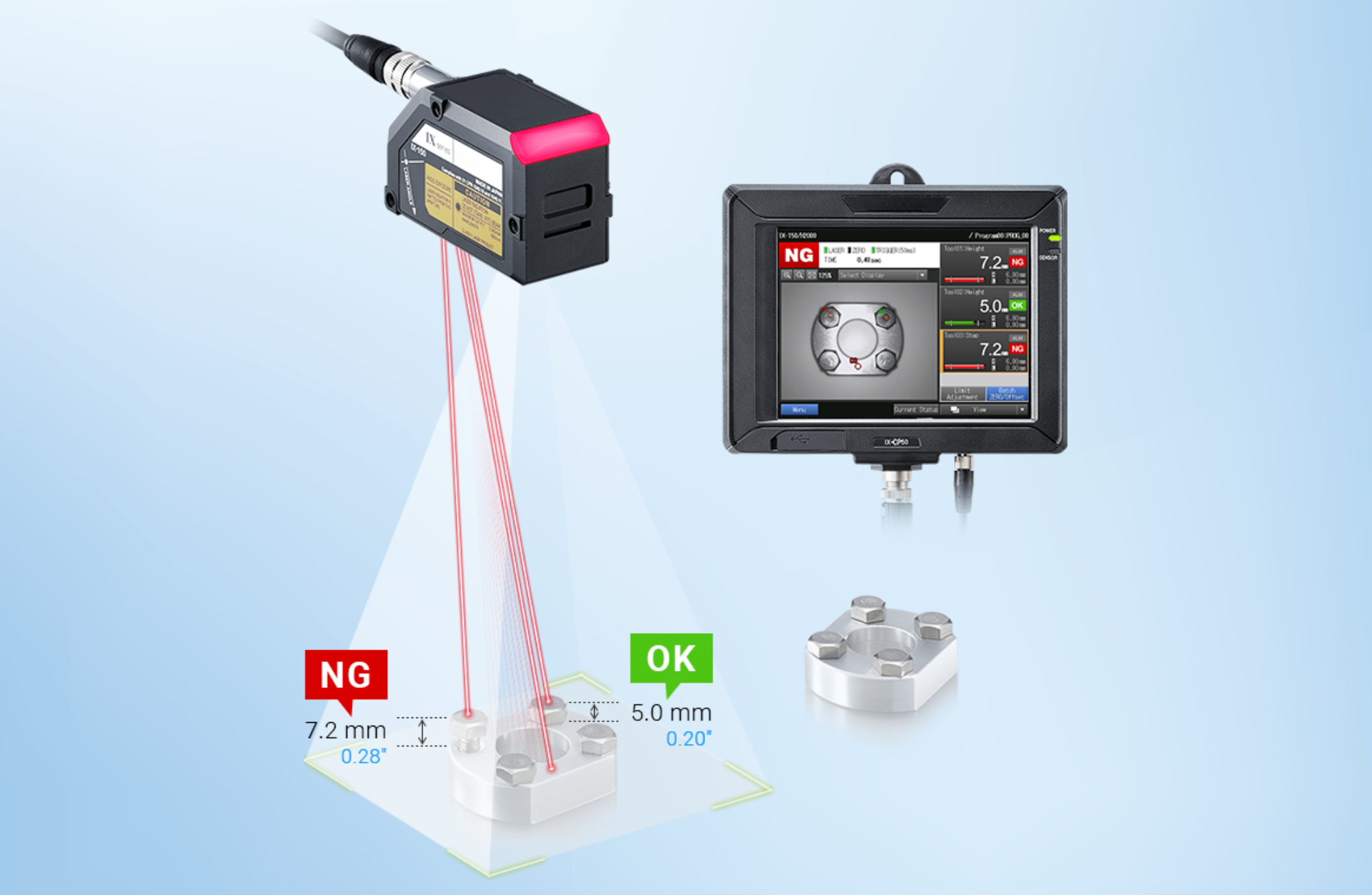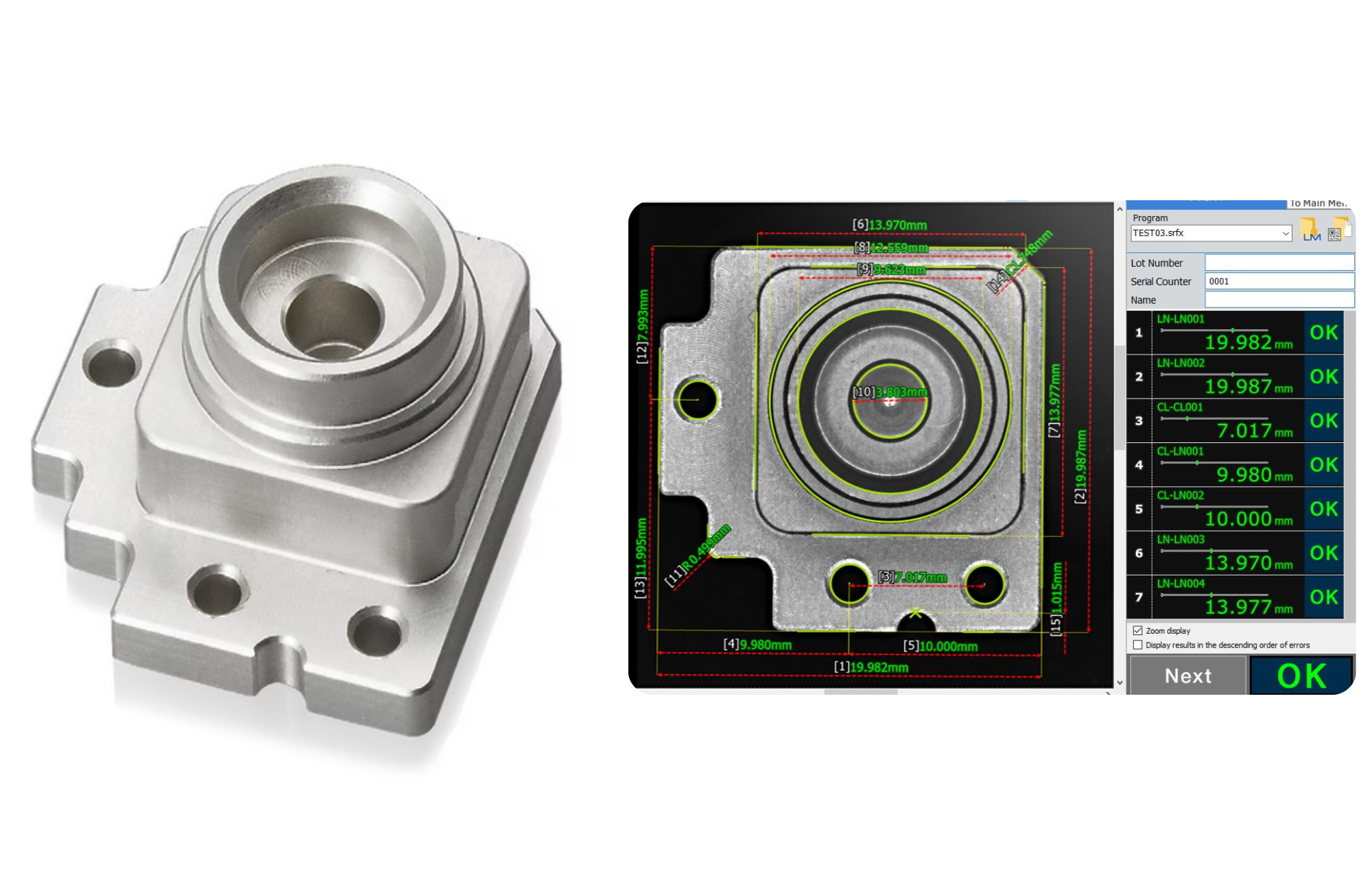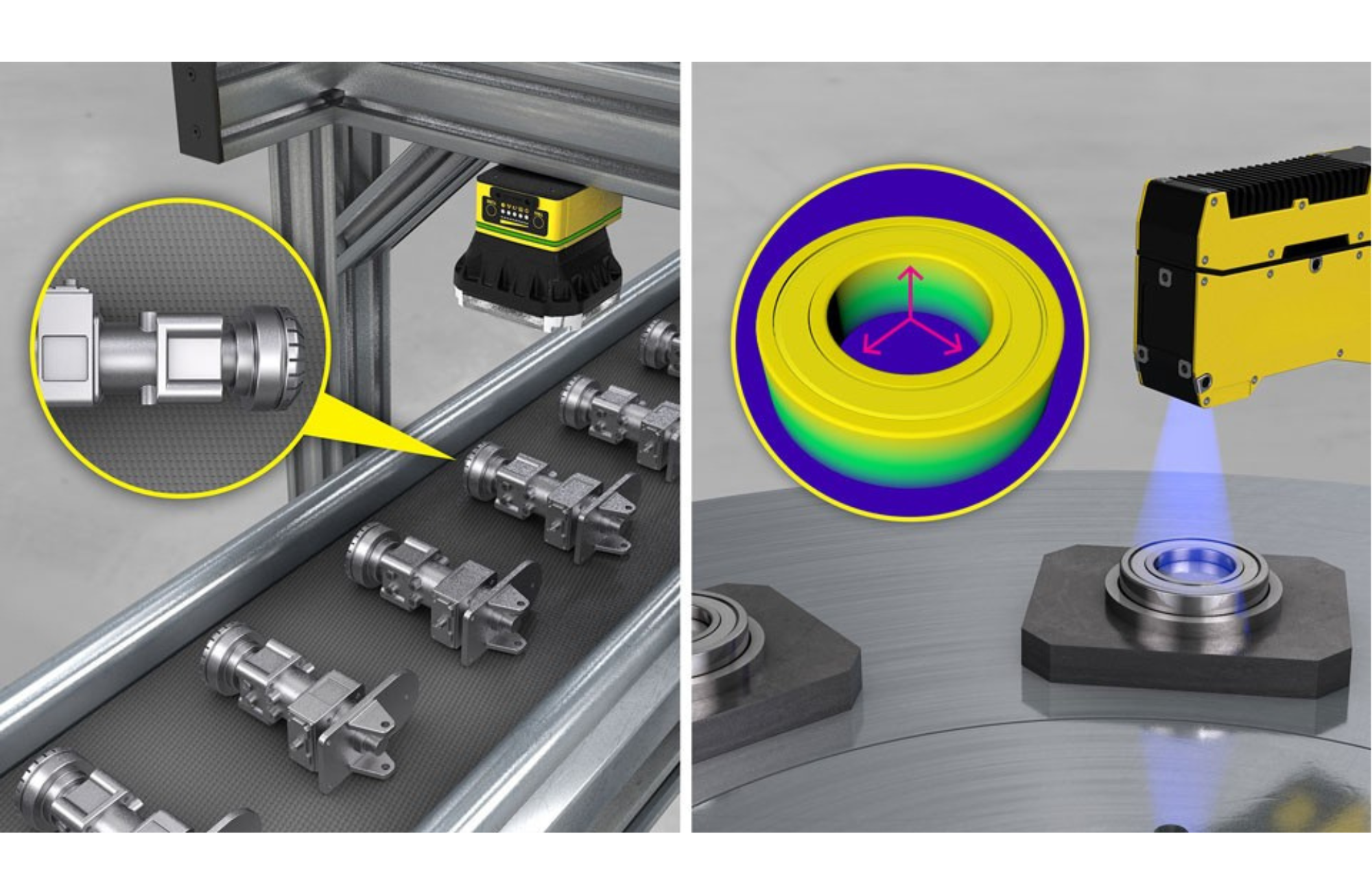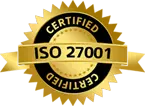Dimension Measurement of Small Machinery Parts in Manufacturing with Non Contact Measurement Solutions
Published on: Apr 23, 2025

Written by: Content team, Intelgic
Dimension Measurement of Small Machinery Parts in Manufacturing with Machine Vision AI
In today’s fast-paced and precision-driven manufacturing environment, the accurate measurement of small metal machinery parts is more important than ever. These components may appear modest in size, but their performance is often mission-critical. Whether used in aerospace, automotive, robotics, or medical devices, even the slightest dimensional error can result in functional failure, safety risks, or costly rework.
Small metal components—such as gears, pins, brackets, housings, fasteners, and inserts—often feature:
- Complex, miniature geometries
- High aspect ratio holes
- Threaded or grooved areas
- Tight tolerances (±2–10 microns)
These intricate characteristics present serious challenges for traditional contact-based measurement tools, which may struggle to access tight spaces or detect micro-level deviations. Non-contact measurement systems, on the other hand, are specifically engineered to resolve fine details with exceptional accuracy and clarity. They often uncover micro-defects or subtle dimensional variations that would otherwise go unnoticed—ensuring that parts meet stringent quality standards and perform reliably in demanding applications such as aerospace engines, automotive transmissions, robotic actuators, and precision surgical tools.
This article explores the challenges of measuring small metal parts, highlights the pivotal role of non-contact measurement solutions, outlines key features of Intelgic’s advanced technology, and showcases its impact across industries.
The Role of Non-Contact Measurement Solutions in Measuring Small Machinery Parts
To Overcome this Challenges non-contact measurement solutions step in as a transformative technology, redefining how manufacturers maintain dimensional accuracy, ensure quality, and streamline production.
Non-contact measurement systems employ advanced optical technologies such as laser triangulation, structured light, confocal sensors, and high-resolution machine vision cameras to capture dimensional data from components without making physical contact. These systems are specifically designed to handle the complexity and precision required for small-scale metal parts that often feature tight tolerances, intricate geometries, and sensitive finishes.
Eliminating the Limitations of Contact-Based Methods
Traditional contact measurement tools—such as calipers, micrometers, and coordinate measuring machines (CMMs)—require physical interaction with the component. While suitable for some applications, they present several limitations:
- Risk of part damage, especially with finely finished or delicate features.
- Slower inspection speeds, especially in high-throughput environments.
- Difficulty in accessing tight or complex features, such as internal grooves or micro-cavities.
- Operator dependency, which can lead to inconsistency and human error.
Non-contact measurement systems operate using advanced optical technologies to inspect components without physical interaction. These systems typically project a focused light source—such as a laser beam or structured light pattern—onto the surface of the part being inspected. As the light interacts with the surface geometry, reflected signals are captured by high-resolution optical sensors or machine vision cameras positioned at precise angles.
The reflected light is then processed to generate 2D or 3D point cloud data, which represents the surface topology of the part with extremely fine detail. This digital model serves as the foundation for extracting a wide range of critical dimensional measurements, including:
- Outer and inner diameters
- Depths of bores or cavities
- Thread pitch, angle, and profile accuracy
- Surface flatness and roughness characteristics
- Edge radius and contour sharpness
- Height, width, and symmetry across multiple axes
For small metal machinery parts, this technology is especially powerful. These components often feature compact, intricate features that traditional probes or contact-based tools may struggle to access. With non-contact systems, both macro-level forms and micro-scale details can be inspected thoroughly—without touching, altering, or damaging the part.
Backlighting in Enhanced Edge Detection
Backlighting is a powerful addition to non-contact measurement systems, particularly when inspecting small metal parts with fine or sharp-edged features. In this technique, a light source is placed behind the component, creating a high-contrast silhouette that allows cameras to clearly capture the part’s outer geometry.
This silhouette enables highly accurate measurement of:
- Outer contours and edges
- Small holes or cutouts
- Thin walls and profiles
- Burrs or edge breaks
Backlighting enhances edge visibility and complements front-facing illumination methods like lasers or structured light. It’s especially useful for parts with complex outlines or minimal reflectivity, ensuring consistent results even on difficult-to-inspect geometries.

Step-by-Step Process of Dimension Measurement for Small Metal Parts in Manufacturing
Accurate dimension measurement of small metal parts is a critical quality control step in modern manufacturing. Non-contact measurement systems streamline this process with a seamless and efficient workflow designed to ensure precision, repeatability, and traceability.
1. Part Loading
Small metal parts are positioned on the conveyor either manually aligned or automatically guided into the inspection area.
2. Illumination and Imaging Setup
The system uses structured light, laser triangulation, or backlight illumination to highlight edges, contours, and surface features. Backlighting is particularly effective for capturing outer profiles and fine geometries, improving edge contrast and measurement accuracy.
3. Image Acquisition and Data Capture
High-resolution machine vision cameras and sensors capture detailed 2D images or generate 3D point clouds. This raw data forms the basis for dimensional calculations, capturing features such as:
- Outer and inner diameters
- Hole depth and bore concentricity
- Thread pitch and profile
- Edge and corner geometries
- Surface flatness and height variations
4. Dimensional Analysis and Comparison
Advanced software algorithms analyze the captured data in real time. Measurements are compared against predefined CAD models or tolerance thresholds to determine pass/fail status.
5. Automated Decision-Making
Based on inspection results, the system can:
- Flag defective parts
- Trigger alerts for deviations
- Send commands for rework or rejection
- Provide real-time feedback to upstream machining processes
6. Data Logging and Reporting
Every measurement is logged for traceability and compliance. The system generates visual reports, trend charts, and statistics that support:
- Regulatory documentation
- Continuous improvement initiatives
- Predictive maintenance using AI analytics
7. Feedback Loop for Process Optimization
Inspection data can be integrated with manufacturing execution systems (MES) or AI-based analytics platforms to adjust machining parameters, detect tool wear early, and improve overall production quality.

Advantages of Non-Contact Measurement Solutions
Non-contact dimension measurement offers several key benefits over traditional contact-based inspection methods:
1. Speed and Efficiency
By eliminating the need for manual handling, non-contact systems dramatically reduce inspection time. This accelerates production workflows and improves overall throughput.
2. Enhanced Precision
Optical and laser-based sensors offer superior resolution and accuracy, particularly when dealing with extremely small or detailed features.
3. Reduced Wear and Maintenance
With no mechanical contact, there’s minimal risk of wear and tear on the system or the part, resulting in longer equipment life and lower maintenance costs.
4. Automation Compatibility
These systems can be seamlessly integrated into existing automation frameworks, enabling inline inspection and eliminating bottlenecks in quality control.
5. Repeatability and Reliability
Consistent and reproducible measurements help maintain product quality over long production runs, reducing defects and customer complaints.

Applications in Various Industries
Non-contact measurement systems have become a cornerstone in multiple sectors, including:
Automotive : Small components like gears, brackets, and fasteners are measured with micron-level precision, ensuring proper fit and performance in engines and transmissions.
Aerospace: Critical parts such as pins and mounting brackets are inspected to meet rigorous aerospace standards, ensuring safety and reliability.
Robotics : Parts used in robotic actuators and automation systems are quickly measured to maintain dimensional accuracy for consistent movement and performance.
Industrial Machinery: Components like bearings and shafts are inspected for tight tolerances to ensure proper function and minimize downtime in machinery.
Medical Devices: Small metal parts, such as surgical instruments and implants, are measured without contact to avoid contamination, ensuring safety and precision.
Tooling: Parts like molds and cutting tools are quickly checked for dimensional accuracy to maintain high-quality production and tool longevity.
Unlock Precision with Intelgic Solutions
Intelgic has established itself as a leader in intelligent automation and quality inspection systems. With years of expertise in AI, machine vision, and industrial automation, Intelgic offers solutions that are not only technologically advanced but also tailored to the specific needs of manufacturers.
Here’s what sets Intelgic apart:
- Customized Deployment: Each solution is designed to integrate smoothly into the client’s existing workflows.
- AI-Powered Intelligence: Intelgic leverages deep learning and pattern recognition to improve inspection accuracy over time.
- User-Friendly Interface: The system features an intuitive dashboard with visual analytics, making it accessible to both engineers and quality inspectors.
- Dedicated Support: A team of experts provides continuous support, training, and updates to ensure maximum uptime and ROI.
Intelgic’s cutting-edge automation and inspection systems empower manufacturers to enhance precision, boost operational efficiency, and ensure the highest product quality. With a focus on customization, AI-driven intelligence, and comprehensive support, Intelgic provides solutions that are not only future-proof but also tailored to the demands of your production environment. Whether you're improving a single line or scaling to meet global manufacturing standards, Intelgic is the partner you can trust for long-term success in quality automation.

